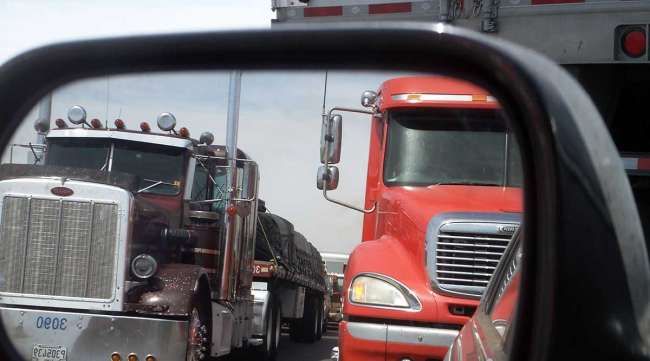Speed-Limiter Regulation Hits Roadblock in Trump’s Quest to Cut Rules

Years of pleas from parents whose son was killed by a speeding tractor-trailer, buy-in from some truckers and the promise of fewer highway deaths convinced U.S. officials in September to propose requiring speed-limiting devices on all large rigs.
All it took was a few minutes for President Donald Trump to sign an order putting that regulation and hundreds of others in limbo.
“This ought to be the biggest slam dunk you ever thought of,” said Steve Owings, whose son, Cullum, died in 2002. The latest hurdle for the truck-speed proposal is “very, very disconcerting,” Owings said.
Trump brought a reformer’s zeal against regulations into the White House, vowing to block what he calls unnecessary rules across the government that stifle business and slow hiring. The order he signed in January requires agencies to kill two existing rules for each new one and caps the costs of new regulations — even ones backed by industry, lawmakers and the public.
At the Department of Transportation, for example, it has brought a near halt to the regulatory process, forcing delays or rethinking of rules brokered through years-long efforts at compromise, enjoying at least some industry support and projected to create significant benefits.
The speed-limiting devices for trucks — already mandated in most developed nations — would save hundreds of lives, lower fuel use and provide as much as $6.5 billion in benefits per year, the department estimated.
If a rule like the truck-speed restriction is to get finalized, agencies have to find a way to save billions of dollars by cutting other regulations. The president has cast the effort as a way to free business of unnecessary burdens.
‘Morality Play’
It’s a “simplistic morality play” to say regulations are either inherently harmful to business interests or are purely for the benefit of the public, said Jerry Ellig, a senior research fellow at the George Mason University’s Mercatus Center who specializes in the issue.
“Most regulations benefit some businesses and harm other businesses,” he said.
Under the umbrella of transportation agencies regulating aviation, automobiles, rail and highways, of the 43 proposed rules subject to review under Trump’s order, 34 — or 79% — are designed to improve safety, according to a Bloomberg News review.
Two would attempt to mitigate the hazards of trains hauling oil, which have derailed and exploded in recent years. Two more, born from the last major U.S. airline accident that killed 50 people in 2009, aim to improve pilot performance. Including the Owings’s truck proposal, at least 10 are focused on reducing the carnage on U.S. roadways, which took 35,000 lives in 2015.
At least 15 of DOT’s actions were designed to address concerns raised by National Transportation Safety Board investigations of accidents.
For safety advocates like Deborah Hersman, the former NTSB chairman who now heads the nonprofit National Safety Council, it’s frustrating seeing DOT’s proposed rules being held up while the agency searches for rules it can undo.
“It’s like Sophie’s Choice. You’re asking people to pick between one thing that will kill you and another thing that will kill you,” Hersman said.
Required by Congress
Almost half of the pending regulations were required, at least in part, by Congress. They include rollover enhancements for motor coaches and safety upgrades for U.S. transit systems. While agencies are bound to adopt rules mandated by Congress, they generally must still find cost savings and other regulations to cut, according to White House guidance.
The new policies apply to proposals that would cost society more than $100 million or are deemed unusual, a category known as “significant.” Military, national security and foreign affairs regulations are exempt.
The result is that it’s almost certain to be harder for agencies like the Transportation Department to enact new rules, according to Richard Morgenstern, a fellow at the nonpartisan Resources for the Future and a former U.S. official with experience in crafting regulations.
“You now have additional constraints which you didn’t have before,” Morgenstern said in an interview.
By numerous measures, regulatory actions have slowed under the new administration. DOT hasn’t updated its monthly list of pending rules since Trump took office. It has halted or delayed implementation of some Obama-era rules, such as airline consumer measures and safety rules for electric and hybrid cars. It hasn’t finalized any of the pending regulations it inherited, including the truck-speed measure, according to government records.
The slowdown has occurred across government, from rules governing how coal royalties are calculated to methane gas releases.
In several cases, this slowdown has frustrated the very industries being regulated. Drone groups, for example, have urged swift action to create rules allowing unmanned aircraft to operate over people’s heads, arguing it’s needed to allow the industry to expand. Battery manufacturers also want the United States to adopt regulations restricting how airlines can carry flammable lithium cells so rules are consistent across borders.
To the advocates for Trump’s regulatory slowdown, the purpose isn’t to block new safety measures or rules that would benefit people.
“That would be perverse,” Marcus Peacock, who briefly served in Trump’s Office of Management and Budget and has become executive vice president of the Business Roundtable lobbying group, said at an April public forum.
Peacock and others said that for decades there hasn’t been an incentive to remove outdated regulations or to streamline such things as paperwork requirements on businesses. The Trump orders will push agencies to be more efficient, and it should be easy to find enough savings among existing rules to allow for new regulations, he said.
Costs of Regulations
The stakes for interest groups and society as a whole are enormous.
During the Obama administration, DOT forecast that benefits on 18 of the pending rules — reduced accident deaths and injuries, improved health and lower fuel consumption among other gains — would total almost $200 billion and outweigh costs by more than four to one.
But the regulations also would create a wide array of additional costs for businesses and society, including required purchases of new equipment by companies or, as in the case of the speed-limiter proposal, the financial impact of delays in delivering goods. Those costs are estimated at about $44 billion.
While the cost and benefit estimates are viewed skeptically by conservative groups and some industries, they remain the benchmark for the Trump administration. Under Trump’s regulatory reform orders, that means transportation officials must find billions of dollars in savings by cutting or revising existing rules before finalizing those regulations.
‘Top Priority’
The Transportation Department has allowed some regulations finalized in the final days of the Obama administration to become law, such as training standards for commercial drivers, the agency said in e-mailed statements. Officials believe there are inefficient rules that can be dropped or revised without compromising safety, which is the agency’s “top priority.” So far, details about which existing rules the administration is targeting for elimination have been sparse.
“This is an exciting time in Washington,” the agency said in a statement. “We share the president’s commitment to reducing unreasonable regulatory burdens that stifle innovation and undermine shared prosperity without promoting safety.”
The White House referred a request for comment to OMB, which didn’t respond to emails.
Speed Limiters
One of the most expensive pending transportation regulations — and therefore one requiring the elimination of significant existing regulations if it is ever to become law — is the Owings’s speed-limiter measure.
Cullum Owings, 22, was a college senior on his way to school after Thanksgiving in 2002 when a truck slammed into his car as he was stopped in traffic on a Virginia highway. The truck had been speeding and the driver applied the brakes too late to stop.
Determined to do something, his parents formed a group called Road Safe America. After they and American Trucking Associations, the largest U.S. trade group for truckers, petitioned the government seeking speed limiters, the Republican administration of President George W. Bush began the process of drawing up a proposal in 2007, according to records.
Progress was slow and support mixed. When the proposed rule was finally issued nine years later on Sept. 7, the Owings felt it didn’t go far enough because it would only require the devices on newly built trucks.
Groups representing smaller trucking companies, including the Owner-Operator Independent Drivers Association, argued that limiting speeds wouldn’t reduce crashes. Over time, some members of the ATA got cold feet and the organization raised concerns in comments to the government. But the Trucking Alliance, a group made up of some of the largest trucking companies, many of which already use speed-limiters, has remained in favor, according to an April 12 letter to Transportation Secretary Elaine Chao.
Government reviews found the benefits far exceeded the costs it would impose on industry in delayed shipments of goods. Costs are projected to be from $209 million to $1.6 billion a year. Fuel savings alone would exceed that, the government projected, and overall benefits including fewer highway deaths would range from $684 million to $6.5 billion a year.
Owings said government officials he’s spoken with who are shepherding the regulation seem uncertain how to proceed under the White House’s new guidelines. A financial planner in Atlanta, he says he has sympathy with Trump’s call for reducing wasteful regulations. He just doesn’t think it makes sense for what he sees as a life-saving measure with little downside.
“You would think that this should be so simple,” he said.




